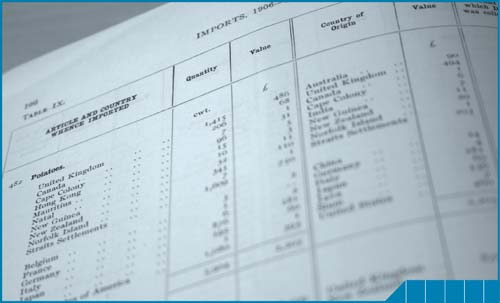|
100 YEARS OF HISTORY MAPPED BY TRADE STATISTICS
1907 — Trade and Customs and Excise Revenue of the Commonwealth of Australia released for the year 1906. Trade surplus [exports – imports / (exports + imports)] 22%.
1917 — Monthly international merchandise trade statistics first published in August.
1930–31 — Following the 1929 Wall Street crash and subsequent onset of the Great Depression, price of wool, metals, timber, apparel, liquor and minerals are hardest hit. Total trade (exports plus imports) reduces 42% from 1929–30.
1942–43 — World War II led to high import and export prices. Largest Australian trade surplus (in percentage terms) 33%.
1943–44 to 1944–45 — Dangers to shipping, as a result of the war, reduces international trade. Trade surplus 16%.
1951–52 to 1952–53 — Record price of wool led to most volatile period for Australian trade. Trade balance shifts from a deficit of 21% in 1951-52 to a surplus of 26% in 1952–53.
1966–67 — The UK relinquishes its position as Australia’s number one leading trading partner. Imports from the USA surpass those from the UK, and Japan replaces the UK as the number one market for exports. Trade deficit 0.3%.
1988 — Harmonised Commodity Description and Coding System (HS) classification introduced enabling consistent international comparison of trade statistics.
2004–05 — China becomes the main source of imports (followed by the USA and Japan), growing 44% since 2002–03. Trade deficit 8%.
2006–07 — Strong growth in China’s demand for Australian minerals exports, more than doubling from 2003–04, contributes to a boom in Australia’s mining industry. China is the second largest export market after Japan, and followed by the Republic of Korea. Trade deficit 4%. |
INTRODUCTION
The year 2007 marked 100 years of the ABS producing statistics on international trade in goods. This centenary of international trade statistics was achieved through strong collaboration between the Australian Customs Service and the Australian Bureau of Statistics (ABS). Australia’s international trading performance has always been a critical component of the Australian economy. Comprehensive, accurate and timely international trade statistics are vital in understanding Australia’s economic performance.
The ABS first published international trade statistics in 1907, soon after its formation (as the Commonwealth Bureau of Census and Statistics) in 1906. Prior to this, trade statistics were compiled by the Government Statistician of each state. The earliest state records are available from 1826.

International trade statistics were first published by the Commonwealth Bureau of Census and Statistics in 1907, for the year 1906.
Australia’s imports and exports statistics are analysed by a large number of organisations, including government agencies, industry analysts and businesses, to formulate policy, support international trade negotiations, evaluate domestic market implications and for international comparison.
COMPILATION
The ABS produces international trade statistics on the value, composition, destination and source of Australia’s merchandise exports and imports. The statistics are compiled using export and import transactions provided by the Australian Customs Service, which are based on information it receives from importers and exporters, or their brokers. Both agencies acknowledge the contribution the importing and exporting community have made and continue to make to the collection and dissemination of reliable merchandise trade data.
DISSEMINATION
The first ABS international trade publication, Trade and Customs and Excise Revenue of the Commonwealth of Australia for the year 1906 (cat. No. 5409.0), was released in June of 1907. This leather-bound publication of 445 pages presents the imports and exports of merchandise, specie (coin) and bullion between Australia and the rest of the world.

The first ABS international trade publication was released in June 1907.
In this very first release of international trade statistics, imported and exported items are recorded along with their value, quantity and country of origin (imports) or destination (exports). The publication extensively details traded items from acids and ale to watches and wigs. The level of detail in the 1906 publication accounts even for singular items, for example, a boat imported from Fiji costing £165.
Today, International Trade in Goods and Services, (cat. no. 5368.0) aggregates the extensive range of traded items under broader categories. For example, previously classified acids would now be aggregated under chemicals and related products; ale would be included in beverages and tobacco; and watches and wigs under miscellaneous manufactured goods.
In a move from a paper based approach, international trade statistics are now disseminated via a range of electronic data formats, including electronic publications, email and disc. The move from hardcopy publications to electronic data presentation makes today’s international trade publications highly accessible. Considerable information can be accessed free of charge from the ABS website, with the most detailed data available upon request.
COMPOSITION
Australia’s international trade statistics have changed markedly over the past century, not only in presentation but also in the composition of imports and exports:
In 1906, Australian imports totalled £44,729,506, with the largest single commodity being apparel and textiles (£12,741,635, approximately 28%) from the UK and Germany. Imports of manufactured metals and machinery, mostly boilers and pumps, were also significant (£9,143,861 or 20%). Exports totalling £66,299,874 resulted in a £21,570,368 trade surplus. The single largest commodity exported was wool destined primarily for the UK, contributing £22,645,769 (34%) to exports. The next largest export commodity was gold specie primarily destined for Sri Lanka, then known as Ceylon, totalling £9,851,558 (15%). The UK was Australia’s major trading partner in 1906, accounting for 59% of imports and 49% of exports.
In 2006-07, imports totalled $181b and the major commodities were road vehicles, $23b (13%), and petroleum products, $21b (13%). From exports worth $168b, Australia’s major commodity exports were coal, $22b (12%), and iron ore, $15b (9%). The Asia-Pacific Economic Cooperation (APEC) countries account for 72% of Australia’s trade and the UK just 4% of both imports and exports. The main sources of Australia’s imports were China (15%), USA (14%), and Japan (10%). Australian exports were primarily destined for the ports of Japan (19%), China (14%) and the Republic of Korea (8%).

USERS AND USES
International trade statistics are an important input to a range of other ABS statistics, including export and import price indexes, the balance of payments and national accounts. International trade data helps provide a comprehensive view of Australia’s national and international economic picture.
In 1906, the use of trade statistics was likely to have been limited. Users were primarily state and Commonwealth governments analysing state trade patterns for budgetary and policy consideration.
| For example, in a Report of the Advisory Committee on Commercial Intelligence of the Board of Trade, early trade statistics were used in an analysis of Australia’s trade position to support the argument in favour of increasing foreign competition. International trade statistics were also used as an indicator of Australia’s prosperity and overall economic performance, in the absence of more vigorous measures. |
Today, international trade statistics at aggregate and detailed levels are used by a wide-range of clients for different purposes, including:
Australian and state/territory government agencies use the data for regulatory and general economic policy purposes, for monitoring commodity trade flows, to assist in the development of trade policy, trade negotiations, monitoring trade agreements and settling trade disputes, and as input to infrastructure planning
economic commentators use the data to report and comment on Australia’s trade with the rest of the world and the impact on the Australian economy
private sector businesses and individuals use international trade statistics to: monitor import penetration and export performance; analyse market shares; assess import competition facing domestic production activities; conduct market research; and assess possibilities for expanding existing markets and developing new markets
international agencies such as the United Nations Statistics Division, the Organisation for Economic Cooperation and Development, the International Monetary Fund and the Food and Agriculture Organization of the United Nations use the statistics for purposes specific to each organisation, and to ensure that Australia is complying with international standards
other national statistical agencies use Australia’s international trade data for analysis and comparison with their own international trade data
financial sector economists, national and international commentators, and public sector agencies in other countries use the data to support their interpretation of international trade statistics and provide advice to their organisations and clients
academics use the data in support of theory and in order to conduct research on international trade
educators and students use international trade statistics to teach/learn about Australia’s economy and its relationship with the rest of the world.
The way in which merchandise trade statistics can be accessed has changed significantly in 100 years. A great deal of data can be accessed free of charge from the ABS website https://www.abs.gov.au or on user-pays basis from ABS Client Services. Merchandise trade data are also available from licensed intermediaries of international trade data, including:
Department of Foreign Affairs and Trade, producing trade statistical publications and providing a consultancy service
Global Trade Information Services Inc., producing international merchandise trade data on the Internet
MariTrade, providing Australian air and sea freight statistics
TradeData International, specialising in foreign trade information and producing customised reports on trade and consultancy services.
CONCLUSION
International trade statistics indicate a country’s economic strengths and challenges. They guide significant cross-border relationships and shape foreign economic policy. The publication of international trade statistics has come a long way since 1907, as has Australia’s international trade position in an increasingly globalising world. The production of quality merchandise trade statistics has enabled the analysis and monitoring of Australia’s international trade, allowing Australia to develop and maintain a successful trade strategy and prosperous global economic position.
The ABS and the Australian Customs Service together celebrate 100 years of providing reliable and readily accessible international trade statistics for varied uses, most importantly as a measure of Australia’s economic performance in a complex global environment.
For further information about statistics in this article refer to:
ABS Catalogue No. 1301.0 — Year Book Australia 1901–1907
ABS Catalogue No. 1301.0 — Year Book Australia 1908
ABS Catalogue No.1301.0 — Year Book Australia 2001. ‘Trade Since 1900’ pp.1035–1039
ABS Catalogue No. 1382.0 — Informing a Nation: The evolution of the Australian Bureau of Statistics 1905–2005
ABS Catalogue No. 5302.0 — Balance of Payments and International Investment Position, Australia, June 2007
ABS Catalogue No. 5368.0 — International Trade in Goods and Services, Australia, June 2007
ABS Catalogue No. 5409.0 — Trade and Customs and Excise Revenue of the Commonwealth of Australia for the year 1906
ABS Catalogue No. 5489.0 — International Merchandise Trade, Australia, Concepts, Sources and Methods, 2001 |
 Print Page
Print Page